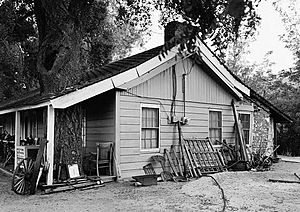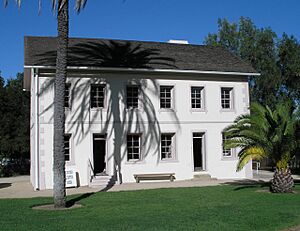Butterfield Overland Mail in California facts for kids
The Butterfield Overland Mail in California was a special mail and passenger service. The United States Congress started it on March 3, 1857. It ran until June 30, 1861. After that, other stagecoach companies used parts of the route. This continued until the Southern Pacific Railroad reached Yuma, Arizona in 1877.
Contents
History of the Butterfield Route
The Butterfield Overland Mail route was active from 1857 to 1861. It became a very important road for California's early growth. It helped people settle and develop the state.
Main Routes in California

Southern California Route (Second Division)
The Second Division's route started from Fort Yuma in California. It went to Warners Pass. This part of the route followed the Sonora Road. The Sonora Road was an old trail used by Spanish and Mexican travelers. It connected Sonora, México, to San Diego.
The Sonora Road later joined with the Kearney Trail. The U.S. Army used this trail during the Mexican-American War. During the California Gold Rush, many American settlers used this route. They added a road from Warner's Pass to Los Angeles.
The route crossed the Colorado River from New Mexico Territory (now Yuma, Arizona). It then went into Baja California, Mexico. This part was about 129 miles (208 km) long. It helped avoid the large Algodones Dunes sand barrier in the Colorado Desert. The Mexican route also had stations with water. This water came from the Colorado River's spring floods into the Alamo River and New River.
The route then came back into California. It crossed the Yuha Desert. It went through the Carrizo Impact Area and up Carrizo Wash. This led through the Carrizo Badlands to Carrizo Springs Station. From there, it went up Carrizo Creek. It passed through the Carrizo Impact Area again. The route then reached the oasis of Vallecito Station.
From Vallecito, the route went northwest into the Peninsular Ranges. It crossed the Laguna Mountains at Warner's Pass to Warner's Ranch Station. Then it continued to Temecula Station. The end of this route was Los Angeles. Los Angeles was also the main office for the Second Division of the Overland Mail. Their office was in a brick building in the Pueblo de Los Angeles. It had an office, a blacksmith shop, stables, and sheds.
Northern California Route (First Division)
The First Division's route went north from Los Angeles. It followed the Stockton–Los Angeles Road. This road was created during the California Gold Rush. It was a southern way to reach the goldfields. The route went through the San Fernando Valley. There was a stop at Rancho Los Encinos.
It then went over Fremont Pass out of the Valley. It continued up San Francisquito Canyon and over San Francisquito Pass. Then it reached the Fort Tejon Pass. From there, it dropped down to the San Joaquin Valley.
The Butterfield route left the Stockton - Los Angeles Road at Elkhorn Spring Station. From there, it went west across the upper San Joaquin Valley. It crossed El Camino Viejo on the Rancho San Luis Gonzaga. It then crossed the Diablo Mountains at Pacheco Pass to reach Gilroy. After Gilroy, it went north through the Santa Clara Valley and San Jose. Its final stop was San Francisco. San Francisco was also the main office for the First Division of the Butterfield Overland Mail.
Stage Stations Along the Route
There were originally 53 Butterfield stage stations in California. Thirty-four stations were in the First Division (Bay Area to Los Angeles). Nineteen stations were in the Second Division (Los Angeles to Colorado River). These stations were usually 8 to 38 miles (13 to 61 km) apart. The total length of the route across California was about 742 miles (1,194 km).
Later, six new stations were added to fill larger gaps between stops.
- Four stations were added in the southern Colorado Desert. These were in Imperial County (California) and Baja California (México). They provided more water and fresh horses. This was important in the hot desert climate. One of these was Sackett's Wells. It was 17.5 miles (28.2 km) southeast of Carrizo Creek Station. It was also 15 miles (24 km) northwest of Indian Wells Station.
- A fifth station was added in the western Mojave Desert. This was at Mud Spring in the Antelope Valley.
- A sixth station was added in the Temecula Valley of the Peninsular Ranges. This was the Willow Springs Station.


